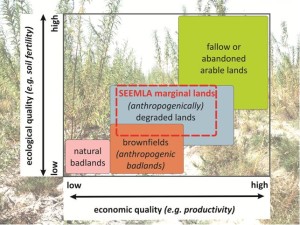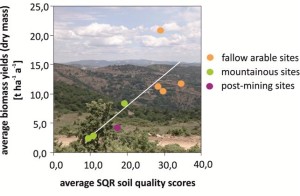Large areas of marginal lands can be found all over Europe. However, legal and political restrictions often impede the utilization of marginal lands for biomass production.
Launched in 2016, the EU-funded project “Sustainable exploitation of biomass for bioenergy from marginal lands” (SEEMLA) aims at establishing suitable innovative land-use strategies for a sustainable production of bioenergy on marginal lands while improving general ecosystem services. The main objective is to contribute to the mitigation of the fast growing competition between traditional food production and production of renewable bio-resources on arable lands. SEEMLA elucidates national differences between legal and political frameworks pointing out opportunities and tailor made solutions for standardization and further development. In general, marginal lands cannot be used economically for conventional agriculture as soils show low fertility potentials due to degradation or other environmental constraints. The SEEMLA approach foresees to consider these lands as a basis for cultivating different bioenergy crops. This approach includes lignocellulosic crops such as switchgrass or miscanthus for producing second-generation or advanced biofuels so that the environmental benefit of bioenergy production can be optimized. The focus of most SEEMLA case studies, however, is on fast growing tree species such as willow, poplar, black locust or pine.
The project consortium consists of eight experienced partners from four European countries of South-East, Eastern and Central Europe (Germany, Greece, Italy and Ukraine), representing three climatic regions. In each of these regions, case study sites have been established. Pilot cases demonstrate potentials and different approaches for utilizing marginal lands. The team itself is balanced between scientific and technical partners as well as national and regional organizations.
Understanding marginal lands – categories of underutilized lands

In order to increase biomass production for bioenergy on marginal lands and to create a corresponding basis for policy and legal frameworks in Europe, the definition and classification of marginal lands must be well-defined for all actors dealing with this type of biomass. Further, it is necessary to provide information about soil fertility potentials and environmental constraints as a basis for selecting suitable bioenergy crops and cultivation practices. As one of the first tasks, therefore, SEEMLA tackled the problem of general understanding of marginal lands and its limitations, taking other relevant approaches referring to marginal land into account.
Various definitions of marginal lands can be found in the scientific literature which mainly reflect the nature of land use and do not provide any information about environmental or economic qualities. Being suspended from agricultural practice, marginal lands have been called, e.g., ‘idle’, ‘abandoned’, ‘surplus’, ‘degraded’, ‘waste’ or ‘set-aside’. SEEMLA tried to sum up these existing definitions. As a result the SEEMLA approach focuses on sites mainly affected by anthropogenic degradation, i.e. mismanagement of land (see Figure 1).
Marginal land according to the SEEMLA definition does not include sites with potentially high productivity which were set aside or were temporarily abandoned due to certain socio-economic reasons. In addition, badlands with naturally extremely low soil fertility as well as most parts of brownfields or anthropogenic, highly contaminated wastelands are also not within the focus of the SEEMLA approach. By using this definition, conflicts with other land use options, such as nature conservation, forestry or agriculture, are expected to be minimized when underutilized land is selected for future biomass production.
In addition to environmental and economic constraints, a comprehensive list of legislative limitations within the European countries was compiled by SEEMLA illustrating pending political decisions with respect to utilizing marginal lands. Currently, the potential use of marginal lands has not been specified on the regional, national and EU level in addition to the still missing official EU definition for marginal lands. However, in the near future, it is the aim of SEEMLA to offer policy recommendations that will also include the important aspect of using marginal lands for biomass production for bioenergy in a sustainable manner.
Assessing marginal lands – tools for quantifying marginality
In literature, published figures regarding the extent of marginal land areas all over Europe vary considerably. One reason for this is the unclear definition of marginal lands as mentioned before and the absence of suitable tools for a sound quantification of this type of lands. Large potentials are reported particularly for Eastern Europe, where substantial parts of formerly cultivated land have been taken out of production during the last decades. The driver behind this development is the technological progress in the food and feed sector, the new environmental, economic and financial issues, and a resulting concentration of highly intensive agriculture on most fertile sites.

Based on a method for quantifying soil fertility of arable land, the SEEMLA consortium was able to successfully assess the marginality of selected case study sites in Ukraine, Greece and Germany. The application of the Muencheberg Soil Quality Rating (SQR) tool allows for an easy access to a large number of different marginality criteria and indicators similar to those elaborated for identifying severe natural constraints to agriculture in the EU (Areas with Natural Constraints, ANC). By applying the SQR method, the following biophysical properties and environmental constrains are assessed and quantified: shallow rooting, low nutrient content, stony texture, sandy texture, clayey texture, salinity, sodicification, acidification, over-wetting, erosion, and contamination as well as climatic conditions.
Figure 2 illustrates the relationship between the soil fertility as quantified by means of SQR scores and average biomass yields for different bioenergy plants grown at the SEEMLA case study sites in Europe. The sites have been classified into three groups: Abandoned arable land is frequently found in Eastern European countries and offers some potential for agriculture but its fertility is usually clearly limited compared to other sites. Mountainous sites (particularly in Mediterranean regions) often exhibit very shallow rooting depth due to degradation by erosion processes. In addition, post-mining sites (investigated in Eastern German lignite mines) are characterized by very low humus and nutrient contents and partly by extreme acidification potentials.
A GIS tool was developed adopting the SQR assessment method as its methodological background. Using available environmental data – mainly soil-related data – and excluding unsuitable sites (e.g. classified areas for nature conservation), it was possible to give a first quantification of marginal lands in Europe.
Utilizing marginal lands – catalogue of bioenergy plant
One central objective of the SEEMLA approach is to provide producers interested in growing biomass with information about bioenergy crops suitable for specific site conditions as reflected by the SQR values of soil fertility or marginality. Part of the SEEMLA action, therefore, was the elaboration of a catalogue of bioenergy crops and of corresponding technologies for planting, harvesting and utilizing these crops. The SEEMLA GIS tool includes the information from the catalogue and is able to suggest suitable bioenergy crops for selected sites, taking into account the respective marginality factors.
Woody and herbaceous crops with high productivity but low demands with regard to site conditions are listed in this catalogue. These species are considered to guarantee stable high biomass yields with high energy capacity from marginal lands of various degrees of marginality.
The SEEMLA project focuses on a sustainable re-conversion of marginal lands for the production of bioenergy. A careful consideration of environmental, economic and social sustainability criteria is needed in this regard. Life cycle assessment (LCA) calculations will be carried out by SEEMLA project partners so that the benefit but also limitations of marginal land for bioenergy production become clearly visible for interested stakeholders, e.g., farmers, forest land owners, and foresters; LCA results are expected in October 2018.
For further information about the project: www.seemla.eu; c.volkmann@fnr.de
Text by Dr. Werner Gerwin, BTU, Germany, Dr. Vadym Ivanina, IBC&SB, Ukraine, Dr. Frank Repmann, BTU, Germany, Dr. Christiane Volkmann, FNR, Germany and Dr. Wibke Baumgarten, FNR, Germany, SEEMLA Project
This project has received funding from the European Union’s Horizon 2020 research and innovation programme under grant agreement No 691874.



